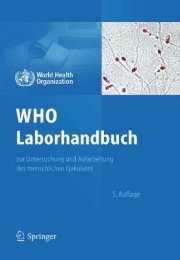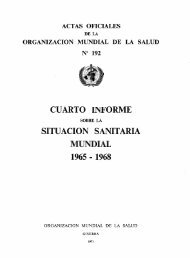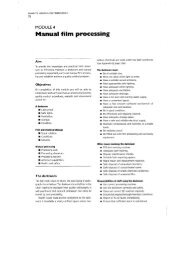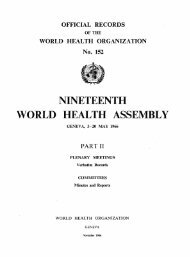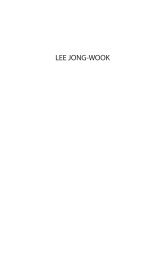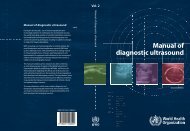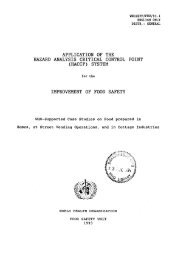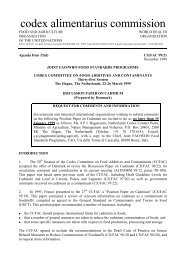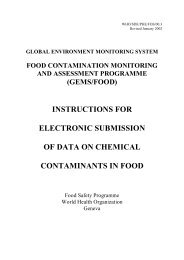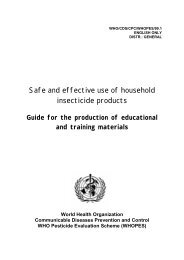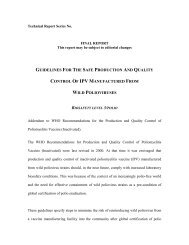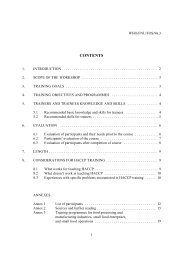N uadThaiTherapy - Multiple Choices - World Health Organization
N uadThaiTherapy - Multiple Choices - World Health Organization
N uadThaiTherapy - Multiple Choices - World Health Organization
You also want an ePaper? Increase the reach of your titles
YUMPU automatically turns print PDFs into web optimized ePapers that Google loves.
Foreword<br />
Foreword<br />
The oldest existing therapeutic systems used by humanity for health and well-<br />
being are called Traditional Medicine or Complementary and Alternative<br />
Medicine (TM/CAM).<br />
Increasingly, TM/CAM is being formally used within existing health-care<br />
systems. When practised correctly, TM/CAM can help protect and improve<br />
citizens’ health and well-being. The appropriate use of TM/CAM therapies and<br />
products, however, requires consideration of issues of safety, efficacy and<br />
quality. This is the basis of consumer protection and is no different, in principle,<br />
from what underpins modern medical practice. Upholding basic requirements<br />
for the modern practice of TM/CAM therapies can support national health<br />
authorities in the establishment of adequate laws, rules, and licensing practices.<br />
These considerations have guided the work of the Regional Government of<br />
Lombardy in TM/CAM which was first included in the Regional <strong>Health</strong> Plan<br />
2002-2004. Clinical and observational studies in the region of Lombardy have<br />
provided a crucial step in the evaluation of TM/CAM. With the help of data<br />
from these studies, a series of governmental provisions have been used to create<br />
a framework for the protection of consumers and providers. The cornerstone of<br />
this process was the first Memorandum of Understanding (MOU) for the<br />
Quadrennial Cooperation Plan which was signed between the Regional<br />
Government of Lombardy and the <strong>World</strong> <strong>Health</strong> <strong>Organization</strong>. The MOU<br />
highlighted the need for certain criteria to be met including: the rational use of<br />
TM/CAM by consumers; good practice; quality; safety; and the promotion of<br />
clinical and observational studies of TM/CAM. When they were published in<br />
2004, the WHO guidelines for developing consumer information on proper use of<br />
traditional, complementary, and alternative medicine were incorporated into this first<br />
MOU.<br />
In the region of Lombardy, citizens currently play an active role in their healthcare<br />
choices. The awareness of the advantages as well as of the risks of every type<br />
of care is therefore critical, also when a citizen actively chooses to use TM/CAM.<br />
Consumers have begun to raise new questions related to the safe and effective<br />
treatment by all providers of TM/CAM. For this reason, the Regional<br />
Government of Lombardy closely follows WHO guidelines on qualified practice<br />
of TM/CAM in order to guarantee appropriate use through the creation of laws<br />
and regulations on skills, quality control, and safety and efficacy of products, and<br />
clear guidelines about practitioner qualifications. The Regional Government of<br />
Lombardy has also provided support and cooperated with WHO in developing<br />
this series of benchmark documents for selected popularly used TM/CAM<br />
therapies including Ayurveda, naturopathy, Nuad Thai, osteopathy, traditional<br />
Chinese medicine, Tuina, and Unani medicine.<br />
Modern scientific practice requires a product or a therapeutic technique to be safe<br />
and effective, meaning that it has specific indications and evidence for care<br />
supported by appropriate research. Practitioners, policy-makers and planners,<br />
vii



